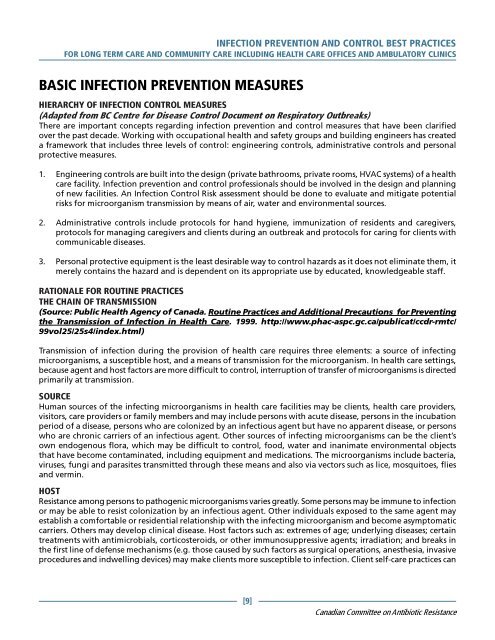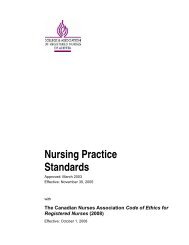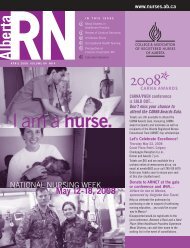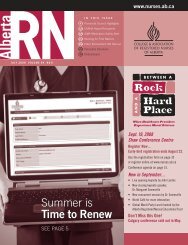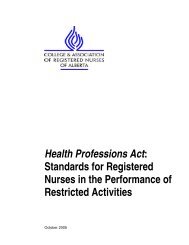Infection Prevention and Control Best Practices - College ...
Infection Prevention and Control Best Practices - College ...
Infection Prevention and Control Best Practices - College ...
You also want an ePaper? Increase the reach of your titles
YUMPU automatically turns print PDFs into web optimized ePapers that Google loves.
INFECTION PREVENTION AND CONTROL BEST PRACTICES<br />
FOR LONG TERM CARE AND COMMUNITY CARE INCLUDING HEALTH CARE OFFICES AND AMBULATORY CLINICS<br />
BASIC INFECTION PREVENTION MEASURES<br />
HIERARCHY OF INFECTION CONTROL MEASURES<br />
(Adapted from BC Centre for Disease <strong>Control</strong> Document on Respiratory Outbreaks)<br />
There are important concepts regarding infection prevention <strong>and</strong> control measures that have been clarified<br />
over the past decade. Working with occupational health <strong>and</strong> safety groups <strong>and</strong> building engineers has created<br />
a framework that includes three levels of control: engineering controls, administrative controls <strong>and</strong> personal<br />
protective measures.<br />
1. Engineering controls are built into the design (private bathrooms, private rooms, HVAC systems) of a health<br />
care facility. <strong>Infection</strong> prevention <strong>and</strong> control professionals should be involved in the design <strong>and</strong> planning<br />
of new facilities. An <strong>Infection</strong> <strong>Control</strong> Risk assessment should be done to evaluate <strong>and</strong> mitigate potential<br />
risks for microorganism transmission by means of air, water <strong>and</strong> environmental sources.<br />
2. Administrative controls include protocols for h<strong>and</strong> hygiene, immunization of residents <strong>and</strong> caregivers,<br />
protocols for managing caregivers <strong>and</strong> clients during an outbreak <strong>and</strong> protocols for caring for clients with<br />
communicable diseases.<br />
3. Personal protective equipment is the least desirable way to control hazards as it does not eliminate them, it<br />
merely contains the hazard <strong>and</strong> is dependent on its appropriate use by educated, knowledgeable staff.<br />
RATIONALE FOR ROUTINE PRACTICES<br />
THE CHAIN OF TRANSMISSION<br />
(Source: Public Health Agency of Canada. Routine <strong>Practices</strong> <strong>and</strong> Additional Precautions for Preventing<br />
the Transmission of <strong>Infection</strong> in Health Care. 1999. http://www.phac-aspc.gc.ca/publicat/ccdr-rmtc/<br />
99vol25/25s4/index.html)<br />
Transmission of infection during the provision of health care requires three elements: a source of infecting<br />
microorganisms, a susceptible host, <strong>and</strong> a means of transmission for the microorganism. In health care settings,<br />
because agent <strong>and</strong> host factors are more difficult to control, interruption of transfer of microorganisms is directed<br />
primarily at transmission.<br />
SOURCE<br />
Human sources of the infecting microorganisms in health care facilities may be clients, health care providers,<br />
visitors, care providers or family members <strong>and</strong> may include persons with acute disease, persons in the incubation<br />
period of a disease, persons who are colonized by an infectious agent but have no apparent disease, or persons<br />
who are chronic carriers of an infectious agent. Other sources of infecting microorganisms can be the client’s<br />
own endogenous flora, which may be difficult to control, food, water <strong>and</strong> inanimate environmental objects<br />
that have become contaminated, including equipment <strong>and</strong> medications. The microorganisms include bacteria,<br />
viruses, fungi <strong>and</strong> parasites transmitted through these means <strong>and</strong> also via vectors such as lice, mosquitoes, flies<br />
<strong>and</strong> vermin.<br />
HOST<br />
Resistance among persons to pathogenic microorganisms varies greatly. Some persons may be immune to infection<br />
or may be able to resist colonization by an infectious agent. Other individuals exposed to the same agent may<br />
establish a comfortable or residential relationship with the infecting microorganism <strong>and</strong> become asymptomatic<br />
carriers. Others may develop clinical disease. Host factors such as: extremes of age; underlying diseases; certain<br />
treatments with antimicrobials, corticosteroids, or other immunosuppressive agents; irradiation; <strong>and</strong> breaks in<br />
the first line of defense mechanisms (e.g. those caused by such factors as surgical operations, anesthesia, invasive<br />
procedures <strong>and</strong> indwelling devices) may make clients more susceptible to infection. Client self-care practices can<br />
[9]<br />
Canadian Committee on Antibiotic Resistance


